Battle-ready warriors: Viking weapons and armour explained
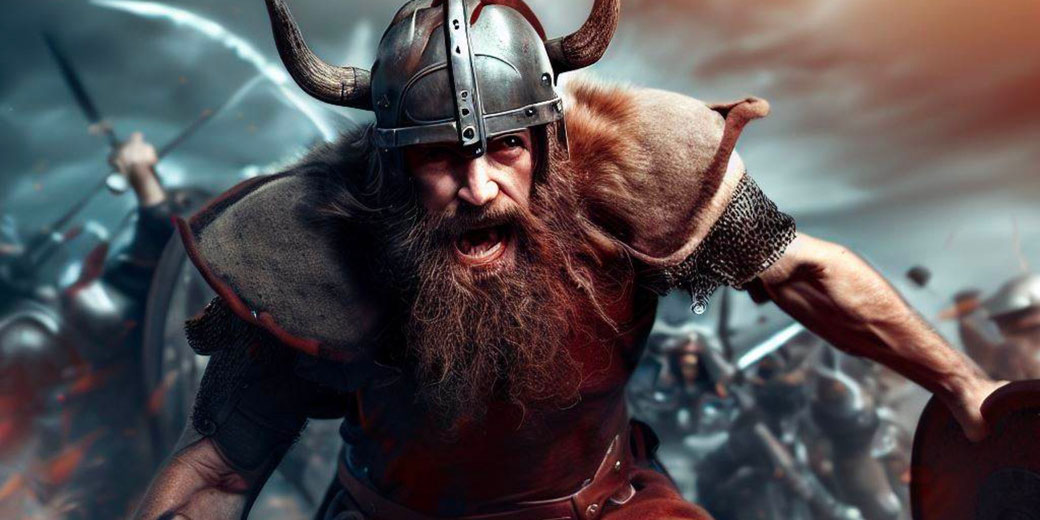
From the icy fjords of Scandinavia, a fearless and ferocious culture arose that would profoundly shape the history of Europe - the Vikings.
Known as the Norse seafarers, they terrorized, traded, explored, and settled across wide swaths of the European continent, the North Atlantic islands, and even the northernmost parts of North America from the 8th to the late 11th century.
But what armed these warriors for their daring voyages and fierce combat?
Behind the Viking façade of ruthless raiders, there existed skilled craftsmen and artisan culture with the ability to forge tools of war that were not just functional, but also intricate works of art.
The Viking armament was an array of weaponry and armour, each piece telling its own story of design, function, and significance.
Swords, axes, spears, and bows comprised their offensive arsenal, while shields, helmets, and body armour like chainmail offered defense in the heat of battle.
Yet, their gear was more than mere tools for war; it embodied their social status, belief systems, and cultural identity.
The weapons and armour of the Vikings, often adorned with intricate engravings, served as symbols of power and prestige, and they were instrumental in rites like funerals, depicting their deeply held belief in the afterlife.
Who were 'the Vikings'?
The Viking Age, a period roughly defined from the late 8th to the early 11th century, was a time of exploration, conquest, and cultural exchange that left an indelible mark on the historical landscape of Europe and beyond.
Originating from the Scandinavian lands of Denmark, Norway, and Sweden, these Norse seafarers embarked on far-reaching voyages, their longships reaching as far as the British Isles, mainland Europe, Iceland, Greenland, and even the northeastern fringes of North America.
Their impact was felt far and wide, from Russia to the Mediterranean, establishing trade routes, colonies, and influencing local cultures and economies.
These explorations and conquests were often enabled by their distinctive martial prowess.
The Viking warriors, or 'berserkers', as some of them were known, instilled fear with their furious attacks, often exploiting the element of surprise.
The weapons and armour that facilitated these campaigns were as varied as the landscapes they navigated, each piece meticulously crafted to serve both practical and symbolic functions.
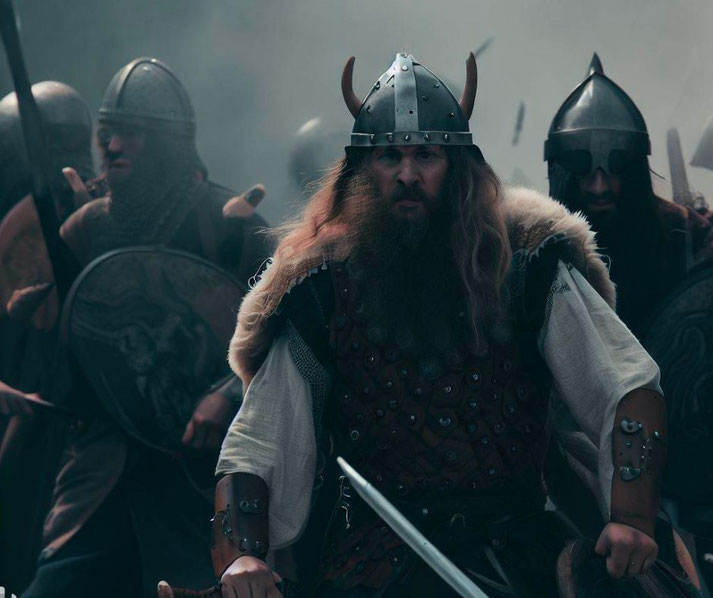
It was an era when weaponry signified more than just a means for warfare; it represented societal standing, personal honour, and religious belief.
Viking society was intrinsically warrior-based, and success in battle often determined an individual's social rank and fame.
A warrior's armament became an extension of their persona, a testament to their skill and bravery on the battlefield.
Consequently, weaponry and armour held a unique place in the societal hierarchy of the Vikings, adding a cultural layer to their functional design.
Moreover, Viking raids and expeditions were not random acts of aggression but rather strategic moves driven by a variety of political, economic, and environmental factors.
An increase in population, limited arable land, political ambition, and the lure of wealth in foreign lands, among other reasons, propelled the Vikings outwards.
The weapons and armour they carried, therefore, were not only tools of war, but also symbols of these larger socio-political narratives playing out during the Viking Age.
How were Viking weapons made?
The majority of Viking armament was made from iron, which was plentiful in Scandinavia.
However, the creation of effective weapons and armour was not just a matter of access to resources; it required significant skill and technological understanding.
The process began with the extraction of iron from bog iron deposits, which were common throughout the Norse lands.
This raw material was then subjected to a series of heating and hammering steps to remove impurities, a procedure known as forging.
The success of this process depended heavily on the blacksmith's skills. To the blacksmith, the iron was not a rigid, unchanging material, but a substance that could be shaped and manipulated into a tool of lethal beauty.
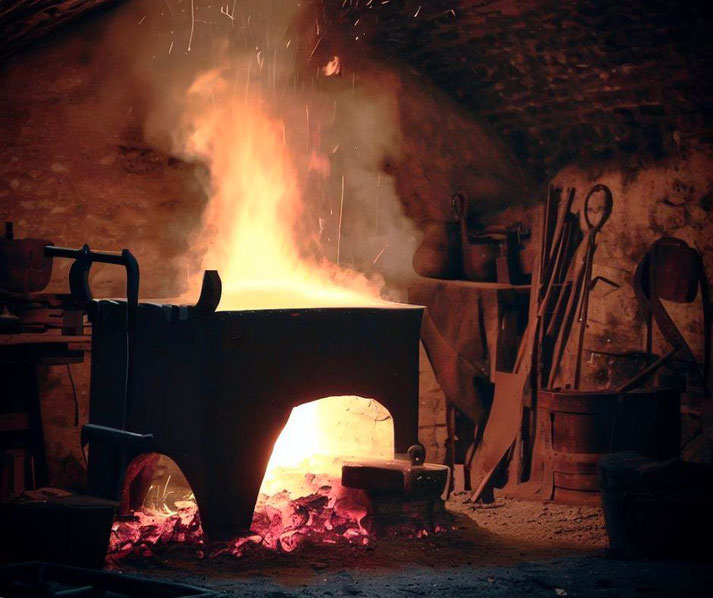
Once the iron was prepared, it was often combined with a small amount of carbon to form steel, a stronger and more flexible material ideal for crafting weapons.
The best Viking swords, for example, were made of pattern-welded steel, a manufacturing process that involved forging together several layers of iron and steel.
This technique created a blade that combined the best attributes of both materials: the hard edge-holding capability of steel and the shock absorption capacity of iron.
The use of steel wasn't limited to swords alone; Viking axes, often the weapons of choice for these seafarers, were made with steel edges as well.
Spears, arrows, and the less common seaxes (a type of single-edged knife) also incorporated steel in their construction.
As for Viking armour, the primary component was also iron, especially in the crafting of helmets and the links in chainmail, though shields were predominantly made of wood with an iron boss at the center.
The design and manufacturing processes involved in creating Viking weapons and armour were a testament to the sophistication of their metallurgy and craftsmanship.
Despite the harsh and often resource-limited environment of Scandinavia, these Norse blacksmiths developed techniques that resulted in weapons and armour that were not just durable and efficient but also artistically striking.
The intricate patterns and symbols often inscribed on these items further demonstrated the craftsmanship of these skilled artisans, elevating their work from mere tool creation to a form of cultural expression.
The most common Viking weapons
When one imagines a Viking warrior, an array of lethal weapons come to mind: swords gleaming in the northern sun, axes capable of cleaving shields, spears that rain death from a distance, and arrows launched from sturdy bows.
Each of these weapons was a product of careful design and craft, imbued with both lethal functionality and symbolic significance.
Perhaps the most iconic of all Viking weapons was the sword. Crafted from pattern-welded steel, these weapons were the pinnacle of Viking metallurgy and craftsmanship.
They were not only a warrior's prized possession but also a significant status symbol.
Viking swords often bore intricate designs and were sometimes named, further accentuating their cultural and personal importance.
Despite their status, swords were not the most common weapon due to the resources and skill needed for their creation.
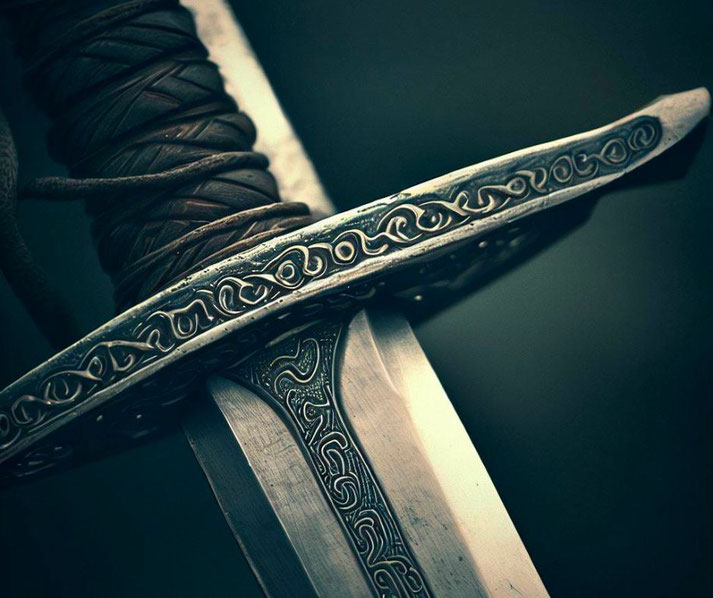
More common in the hands of a Viking warrior was the axe. These were easier and less resource-intensive to manufacture, and hence more abundant.
Axes ranged from simple hand axes to the feared Danish axe, a large two-handed weapon capable of dealing devastating blows.
Beyond their role in battle, axes also served as versatile tools in everyday Viking life, demonstrating their practicality and utility.
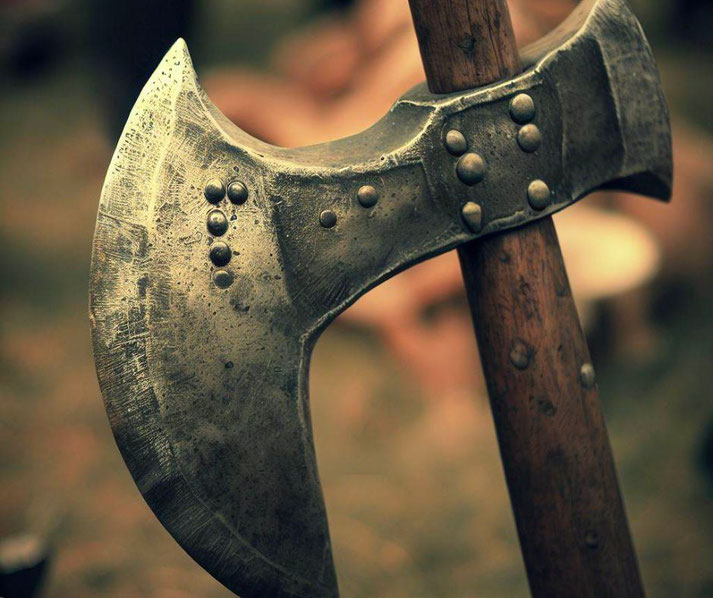
Spears were another widespread weapon among the Vikings. Light, versatile, and cost-effective to produce, the spear was a weapon of choice for many Viking warriors.
It was primarily used for thrusting but could also be thrown if necessary. Often seen as the weapon of Odin, the chief god in Norse mythology, the spear held a sacred significance within the Viking society.
The Vikings also used ranged weapons like bows and arrows. These weapons provided a tactical advantage, allowing Vikings to attack from a distance, especially during ship-based combat.
Bows were typically made of yew, ash, or elm, while arrows were crafted from a variety of woods and topped with iron or bone tips.
Less common, but no less significant, were the seaxes, or single-edged knives. They served a dual purpose, functioning both as a tool and a backup weapon. Seaxes came in different sizes, from small knives to sword-like long seaxes.
In the hands of a Viking, these weapons were more than tools of war. Each held a story, a purpose, and a connection to the culture from which they were born.
The importance of these weapons extended beyond the battlefield and into the realms of the social, the spiritual, and the symbolic.
They were integral to a Viking's identity, serving as an extension of their strength, honor, and heritage.
Viking armour
Viking warfare was not just about the offensive might of their weapons; it was also about effective defense, something facilitated by their armour.
The portrayal of Vikings in popular media often shows them wearing horned helmets and thick, leather armour, but historical and archaeological evidence paints a different picture.
Viking armour was practical, durable, and meticulously crafted, consisting primarily of helmets, body armour, and shields.
Helmets were a crucial component of a Viking warrior's armour, designed to protect the most vulnerable part of the body - the head.
Contrary to popular belief, Viking helmets did not have horns. They were typically made of iron and consisted of several pieces, including a bowl to protect the skull, a nose guard, and sometimes additional protection for the neck and eyes.
Helmets were relatively expensive to produce and required skilled craftsmanship, making them less common and potentially indicative of a higher-status warrior.
Body Armour was even rarer due to the materials and labour required for production.
The most common form was the chainmail hauberk, a shirt made from thousands of interlinked iron rings.
It offered excellent protection against cuts and thrusts without compromising mobility.
However, due to the effort involved in making a chainmail - it could take months to forge - it was likely a luxury that only the wealthiest and highest-ranking Vikings could afford.
There's also some evidence suggesting the use of lamellar armour, consisting of small iron plates laced together, although this was not as common as chainmail.

The primary defensive tool for a Viking warrior was the shield. The round Viking shield was a simple, cost-effective, and versatile piece of armour.
These shields were usually made from planks of softwood, such as pine or fir, for their lightness and flexibility.
The front was often covered in leather for added durability, and a central iron boss protected the hand.
Shields were not just for defense; they were also used offensively to batter opponents.
Additionally, a group of Vikings could arrange their shields to form a 'shield wall', an effective formation for both attack and defense.
It is important to note that not all Vikings would have had access to comprehensive armour.
The majority of warriors likely went into battle with little more than a shield and their clothing, possibly layered for added protection.
The image of an armour-clad Viking warrior decked out in a helmet and chainmail is more the exception than the rule, likely reserved for jarls (nobles) and well-off freemen.
The importance of weaponry to Viking social status
In the hierarchical structure of Viking society, weapons, particularly swords, were potent status symbols.
The resources and skills needed to craft a fine sword were extensive, thus ownership often signified wealth and high social standing.
An ornately decorated sword could speak volumes about a warrior's victories, lineage, and prestige.
This societal link between martial prowess and social status is evident in the sagas and epic poems of the time, where heroes are often portrayed with their trusted weapons at their side.
Viking armour, too, had symbolic value. Chainmail and helmets, due to their high production costs, were likely limited to the wealthier Viking warriors.
Possessing such protective gear was not only a tactical advantage but also a display of wealth and power.
Moreover, shields were often painted and decorated, serving as a canvas to exhibit personal symbols, lineage, or affiliations, adding another layer of cultural meaning to these practical items.
The spiritual world of the Vikings was deeply intertwined with their warfare. Weapons played a significant role in Viking rituals and mythology.
Spears, for example, were associated with Odin, the chief of the gods, and were often used in religious rituals and ceremonies.
Swords were sometimes given names and believed to carry spirits, and they were often included in the burial rites of high-ranking individuals, symbolising the belief in a warrior's afterlife.
The famous ship burial at Sutton Hoo, for example, revealed a wealth of weapons interred with the deceased, indicative of their importance in Viking funerary rites.
Interestingly, the 'berserkers', fierce Viking warriors, brought another symbolic dimension to the armour.
They were said to wear bear or wolf skins into battle, believing these 'spirit animals' lent them strength and ferocity.
This aspect of Viking warfare reflects the intersection of their combat practices with their rich animistic and totemic spiritual traditions.
The cultural and symbolic significance of Viking weapons and armour was immense, permeating societal, spiritual, and personal realms.
These objects were much more than tools for offense and defense; they were integral parts of a complex cultural tapestry, encapsulating a warrior's identity, status, beliefs, and societal roles.
They represented an elaborate fusion of function, art, symbol, and belief, embodying the multifaceted ethos of the Viking Age.
What do you need help with?
Download ready-to-use digital learning resources
Copyright © History Skills 2014-2024.
Contact via email
With the exception of links to external sites, some historical sources and extracts from specific publications, all content on this website is copyrighted by History Skills. This content may not be copied, republished or redistributed without written permission from the website creator. Please use the Contact page to obtain relevant permission.





